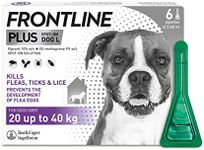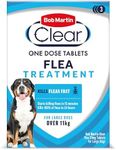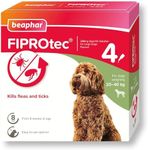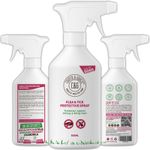Buying Guide for the Best Flea Treatment For Dogs
Choosing the right flea treatment for your dog is crucial for their health and comfort. Fleas can cause a range of issues from mild irritation to serious health problems. When selecting a flea treatment, it's important to consider various factors to ensure you pick the best option for your dog's specific needs. Here are some key specifications to help guide your decision.Type of TreatmentFlea treatments come in various forms such as topical treatments, oral medications, flea collars, and shampoos. Topical treatments are applied directly to your dog's skin and are effective for about a month. Oral medications are ingested and can provide quick relief, often within hours. Flea collars can offer long-term protection, sometimes up to eight months. Shampoos can kill fleas on contact but may not provide long-term protection. Choose the type based on your dog's lifestyle and your preference for ease of application.
Active IngredientsThe active ingredients in flea treatments are what kill or repel fleas. Common ingredients include fipronil, imidacloprid, and permethrin. Each ingredient works differently and may have varying levels of effectiveness and safety. It's important to choose a treatment with an ingredient that is safe for your dog's age, size, and health condition. Consult your veterinarian if you're unsure which ingredient is best for your dog.
Duration of EffectivenessThe duration of effectiveness refers to how long the treatment will protect your dog from fleas. Some treatments need to be applied monthly, while others can last several months. Consider how often you're willing to reapply the treatment and how long you need protection. For instance, if you live in an area with a high flea population, a longer-lasting treatment might be more convenient.
Age and Weight RestrictionsFlea treatments often have specific age and weight restrictions to ensure safety and effectiveness. Puppies and small dogs may require different dosages or formulations compared to adult or larger dogs. Always check the product label for age and weight guidelines and choose a treatment that is appropriate for your dog's specific characteristics.
Ease of ApplicationThe ease of application can vary significantly between different types of flea treatments. Topical treatments and collars are generally easy to apply, but some dogs may resist oral medications or shampoos. Consider your dog's temperament and your own comfort with administering the treatment. An easy-to-apply treatment can make the process less stressful for both you and your dog.
Side EffectsAll flea treatments have the potential for side effects, which can range from mild skin irritation to more serious health issues. It's important to read the product label and consult your veterinarian about potential side effects, especially if your dog has pre-existing health conditions. Choose a treatment with minimal side effects to ensure your dog's safety and well-being.


















